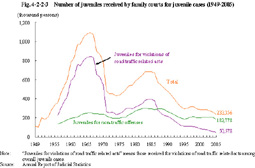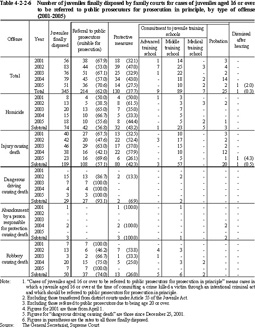| Previous Next Index Image Index Year Selection | |
|
|
2 Juvenile hearing (1) Juveniles received by family courts Fig. 4-2-2-3 shows the trends in the number of juvenile offenders received by family courts since 1949.
The number of juvenile offenders received for violations of road traffic related acts declined sharply after the traffic violation notification system came to be applied to juveniles in 1970 and the range of application of the system was expanded in 1987, and has been on a declining trend ever since. Fig. 4-2-2-3 Number of juveniles received by family courts for juvenile cases (1949-2005) (2) Disposition of juvenile cases a. Outline of final disposition Fig. 4-2-2-4 shows the percent ratio of juveniles finally disposed for [1] non-traffic offenses (excluding juvenile cases concerning negligence in the pursuit of social activities, dangerous driving causing death or injury, pre-delinquencies, and referral to family courts by summary sending of cases; hereinafter the same in this Section), [2] cases such as negligence in the pursuit of social activities (meaning juvenile cases concerning negligence in the pursuit of social activities and dangerous driving causing death or injury), and [3] juvenile cases concerning violations of road traffic related acts in 2005, by type of disposition.
Fig. 4-2-2-4 Percent ratio of juveniles finally disposed by family courts, by type of disposition (2005) b. Disposition for homicide and robbery Fig. 4-2-2-5 shows the percent ratio of juvenile cases finally disposed by family courts for homicide and robbery among non-traffic offenses, by type of disposition (See Appendix 4-10 for the number of juveniles finally disposed by family courts by type of offense).
Fig. 4-2-2-5 Percent ratio of juveniles finally disposed by family courts for homicide and robbery, by type of disposition (2005) c. Referral to public prosecutors for prosecution Table 4-2-2-6 shows the number of juveniles finally disposed by family courts for cases where juveniles aged 16 or over killed victims through an intentional criminal act and that should be referred to public prosecutors for prosecution in principle (excluding those referred to public prosecutors due to being age 20 or over; hereinafter the same in this Section) (limited to cases committed on or after April 1, 2001; hereinafter referred to "cases of juveniles aged 16 or over to be referred to public prosecutors for prosecution in principle" in this Section), by type of offense.
Table 4-2-2-6 Number of juveniles finally disposed by family courts for cases of juveniles aged 16 or over to be referred to public prosecutors for prosecution in principle, by type of offense (2001-2005) |



